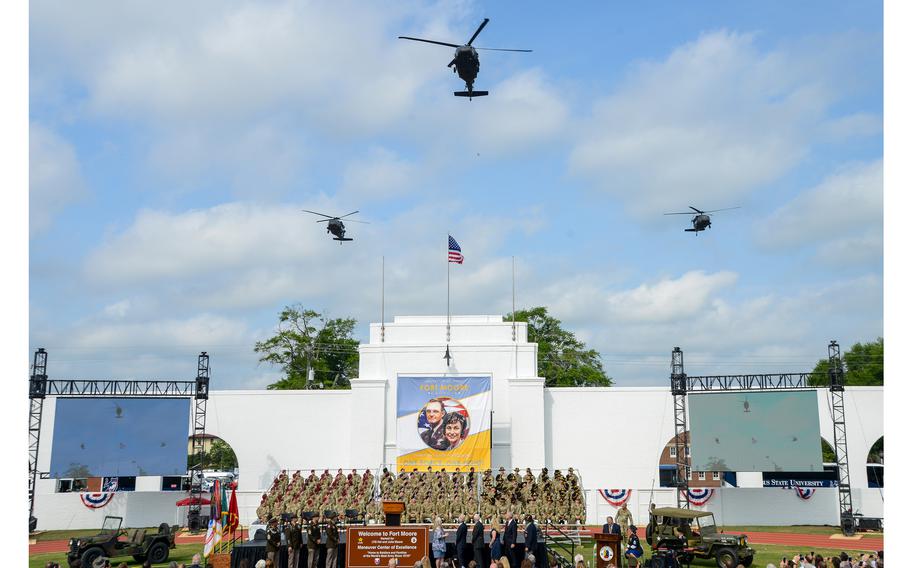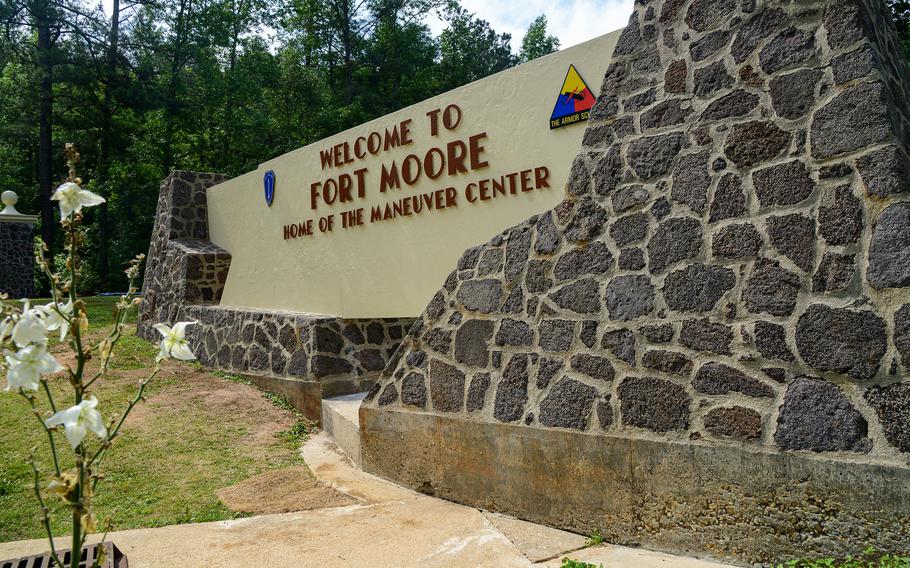
Army Maj. Gen. Curtis Buzzard, the commander of the Maneuver Center of Excellence, and Julie Moore Orlowski, Hal and Julia Moore’s daughter, unveil the new welcome sign for Fort Moore, Ga., during a ceremony Thursday, May 11, 2023, to mark the name change of Fort Benning. (Corey Dickstein/Stars and Stripes)
FORT MOORE, Ga. — The Army’s home of infantry and armor training is now Fort Moore.
Army officials gathered at the Georgia training post to mark the official name change from Fort Benning — a moniker that the installation had held since its founding as Camp Benning in 1918 — to Fort Moore, in honor of Lt. Gen. Hal Moore and his wife Julia Moore. The name change comes as the Pentagon, mandated by Congress, works to rid its installations of names and items honoring those who served the Confederacy.
“Lt. Gen. Hal and Julia Moore were courageous leaders and visionaries whose lives exemplified duty, honor and country, and each time we pass through the gates [of Fort Moore] their legacy will inspire us,” said Maj. Gen. Curtis Buzzard, the top commander of Fort Moore and its Maneuver Center of Excellence. “The home of the infantry and armor forces will now be named after two people who not only embodied but demonstrated the Army values — one on the battlefield, [and] the other on the home front.
“Fort Moore is a name our soldiers and our mission deserve because when recruits sign on to be all you can be in the Army, they come here to be more.”
Against an overcast sky on Thursday morning, Army Col. Colin Mahle, Fort Moore’s garrison commander, and Command Sgt. Maj. Michael Sanchez, its garrison senior enlisted leader, slowly unfurled the installation’s new cream-colored Fort Moore flag to applause from the packed Doughboy Stadium where the Army gathered to celebrate the new name. The Moores spent portions of Hal’s military career at Fort Benning, where they are buried in the post cemetery. They were chosen for the honor as a husband-and-wife unit to honor the importance of the Army family, according to the panel that selected new names for Fort Benning and eight other Army installations in the South.
The Moores’ children — Greg Moore, Steve Moore, Cecile Moore Rainey, Dave Moore and Julie Moore Orlowski — led the push to rename Fort Benning for their parents after the Pentagon’s Naming Commission sought public input into the process. All the Moore children attended the ceremony Thursday.
Steve Moore is a graduate of the U.S. Military Academy at West Point, N.Y., like his father and said it was difficult to find the words to describe his feelings as he looked at a giant banner bearing his parents’ picture with the words “Fort Moore” above them.
“This has been a 2½-year effort to get here, and I just can't believe that we're looking at that placard up there with Mom and Dad's picture and their names,” said Moore, who was born on Fort Benning. “This is humbling, but that’s not even an adequate word. I just can’t believe we’re here.”
The Moore family — more than 60 of whom attended the ceremony — gathered with old friends before and after the ceremony. Among them were nearly a dozen men who served under their father’s command in Vietnam.

UH-60 Black Hawk helicopters fly over Fort Moore, Ga.’s Doughboy Stadium during a ceremony Thursday May 11, 2023 to mark the change in name of the former Fort Benning to Fort Moore. (Corey Dickstein/Stars and Stripes)
It was in Vietnam that Hal Moore first rose to national prominence, commanding the 1st Battalion, 7th Cavalry Regiment at LZ XRay in November 1965 at the opening of the Battle of Ia Drang, the first major U.S. battle of the Vietnam War. Americans at home watched news reports from the battlefield as Hal Moore’s troopers faced an attack from a much larger enemy force. Then a lieutenant colonel, Hal Moore steadily commanded his troops and fought off the attack, leading from the front, said Tony Nadal, a retired Army colonel who was a company commander under Moore in that battle. Moore received the Distinguished Service Cross — the second-highest honor for battlefield heroics — for his actions at LZ XRay.
“If you have to go to war, you want to go to war with the best — and I did,” Nadal said of Moore during the ceremony. “He was the greatest soldier I ever served with.”
Hal Moore, who also served in Korea, would later attain three stars and serve as the Army’s personnel chief. He is credited with taking multiple actions to ensure soldiers had equal opportunities in the service regardless of their race, ethnicity or religion. After retiring, he wrote the bestselling novel “We Were Soldiers Once … And Young” with war correspondent Joe Galloway, who was at Ia Drang as a journalist. The book was turned into a movie, “We Were Soldiers,” with Mel Gibson portraying Hal Moore.
Meanwhile, Julia Moore worked at home to raise her children and care for other military spouses — especially those whose husbands were killed in action. After learning that wives were being informed of their husbands’ deaths by telegrams delivered by cab drivers, Julia Moore worked to ensure the Army sent uniformed soldiers to conduct casualty notifications, according to the Army. She also helped establish Army Community Services and worked with the Red Cross.
Her children described Julia Moore as a go-getter who would support her children through anything — including the family’s 28 moves during Hal Moore’s Army career.
“She was so adaptable,” said Cecile Moore-Rainey, the Moores’ daughter. “She was so full of enthusiasm, and as much as she was doing and as difficult at times as it was as kids, moving constantly [and] meeting new people, we never really saw her as not being available.”
Officials at Fort Moore on Thursday chose to focus on the future, with no official mention during the ceremony of the reason for the change — Henry Benning’s ties to the Confederacy. Benning, for whom the post was named when it was established during World War I, was a local resident who worked as a lawyer and a judge before joining the Confederate army and rising to general. A slave owner, Benning never served in the U.S. Army and worked, even after the Civil War, to promote racial segregation and white supremacy, according to historians.
Gen. Gary Brito, the commander of Army Training and Doctrine Command who attended the ceremony, said he had no message to those who voiced disagreement with changing the names of Fort Benning and other bases.
“Today's ceremony does truly exemplify the character of Gen. Moore, and I think connected that to the long historic mission of Fort Benning — now Fort Moore — and what it has done to train soldiers over the decades,” said Brito, who has spent some nine years of his career at Fort Benning, including as its commander from 2018 to 2020. “I think it is an appropriate recognition.”

Fort Benning, Ga., became Fort Moore on Thursday, May 11, 2023, as part of a Congress-mandated effort to rid the U.S. military of names and items honoring those associated with the Confederacy. Fort Benning was named in 1918 for Confederate Gen. Henry Benning and renamed in honor of Lt. Gen. Hal Moore, a Korean and Vietnam War veteran and bestselling author, and his wife, Julia. (Corey Dickstein/Stars and Stripes)
Fort Moore is one of nine Army posts changing names.
Fort Pickett, Va., Fort Rucker, Ala., Fort Lee, Va., and Fort Hood, Texas, have been renamed Fort Barfoot, Fort Novosel, Fort Gregg-Adams and Fort Cavazos, respectively.
Fort Bragg, N.C., is scheduled to become Fort Liberty on June 2, and Fort Polk, La., will become Fort Johnson on June 13. Dates have yet to be set for name changes at Fort Gordon, Ga., and Fort A.P. Hill, Va.
The service-wide effort is expected to cost some $62.5 million, according to a Defense Department report. Fort Moore’s change was expected to cost some $5 million, but officials at the installation have said that is not a final price tag.
On Thursday, as officials marked the name change at Doughboy Stadium, Fort Moore Department of Public Works officials scoured the post to change out as many signs bearing the name Benning as possible. But, by the afternoon, plenty of reminders of the installation’s long held name remained, including road signs and street names not controlled by the military. Those items could change in the future, but no final decisions had yet been made, said a spokeswoman for the city of Columbus, just outside Fort Moore’s gates.
While Fort Benning might now be Fort Moore, after the ceremony it was back to business as usual at the more than 182,000-acre installation that trains some 20,000 soldiers each week, Buzzard said.
“We're at the epicenter of winning at the Maneuver Center of Excellence,” the general said. “This is exactly what we do. Our name may be changing, but our mission is not. We will continue to train soldiers and leaders to fight and win in the crucible of ground combat.”